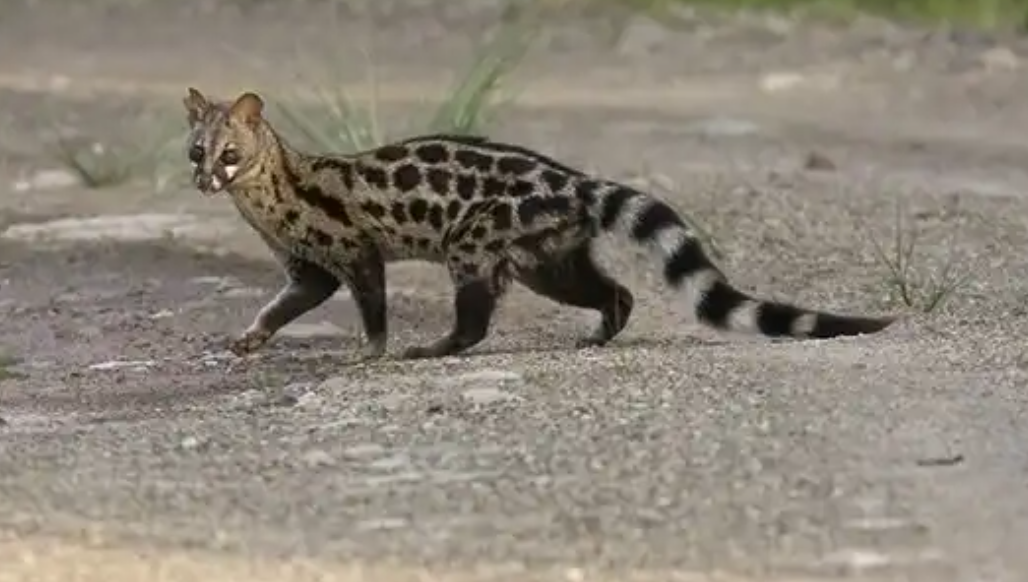Servaline Genet:
The slippery blue blood of the African Timberlands
Presentation:
The Servaline Genet (Genetta servalina), a classy and stealthy animal, hides in the thick forests and forests of sub-Saharan Africa with a riddle chat. Despite its slippery nature, this little carnivore has captivated intrigued analysts and natural life enthusiasts. With its smooth coat, agile developments and nocturnal propensities, the Servaline Genet embodies the hidden charm of the wild spaces of Africa. In this article, we have taken a journey into the secret world of Servaline Genet, studying its physical characteristics, its biological part, its behavioral adjustments, its conservation status and the challenges it faces in a rapidly changing context.
Scientific advancement and categorization:
Part of the Viverridae family, the Servaline Genet offers affiliation with other small carnivores such as civets and mongooses. Its logical title, Genetta servalina, reflects its resemblance to the serval cat (Leptailurus serval) and its classification within the Genetta class. Developmentally, the Servaline Genet likely diverged from its closest relatives millions of times ago, developing special adjustments adapted to life in the forests and forests of Africa.
Physical characteristics:
The Servaline Genet features a slender, stretched body with short legs and a long bushy tail, giving it fit and agility when exploring its arboreal territory. Its skin is delicate and thick, generally ranging in color from pale gray to reddish brown, with dark spots or stripes along its back and sides. This enigmatic coloration aids in camouflage amid the dappled light and shadows of the woodland canopy.
One of the Servaline Genet’s strengths is its huge forward-facing eyes, adjusted for night vision and developmental identification in low light conditions. Its ears are fitted and deeply delicate, aiding in the sonic localization of prey and potential dangers. In general, its physical characteristics reflect its role as a stealthy and lively predator, capable of preying on a group of varied prey in its wooded living space.
Living space and distribution:
Servaline Genet is widely distributed throughout sub-Saharan Africa, extending from Senegal and Gambia in the west to Somalia and Ethiopia in the east, and south to South Africa . It has an assortment of forested living spaces, including tropical rainforests, montane forests, display forests, and savannah forests. Within these environments, it involves both the understory and canopy of woods, using its climbing abilities to reach prey and avoid predators.
Behavior and environment:
As a transcendentally nocturnal predator, the Servaline Genet spends many of its waking hours foraging under the cover of fog. It may be a singular, regional creature, marking its domain with scent organs found on its face, legs and tail. Despite its unique nature, it can tolerate the proximity of its conspecifics in its region, especially during the breeding season.
Servaline Genet’s down is varied, consisting of small warm-blooded animals, feathered creatures, reptiles, creepy crawlies and natural products. It uses stealth and trap strategies to capture its prey, using its sharp claws and teeth to quickly dash to victims. Like other carnivores, it plays a crucial role in controlling prey populations and shaping the flow of the biological system within its environment.
Regenerative Science:
The breeding science of Servaline Genet is known for its secretive nature and the challenges of observing it in the wild. Mating probably takes place throughout the year, with females giving birth to litters of one to four cats after a development period of around two months. Cats are born dazed and helpless, dependent on their mothers for food and safety during their first weeks of life.
Conservation state :
While the Servaline Genet is now classified as a species of least concern by the World Conservation Union (IUCN), it faces various dangers along its journey, including habitat misfortune, fractures and conflicts between humans and wildlife. Deforestation, agrarian expansion and environmental improvement pose critical challenges for the species, reducing accessible living space and widening the divide.
